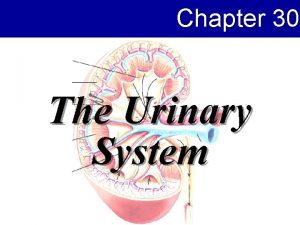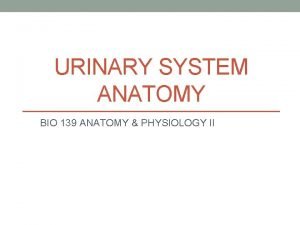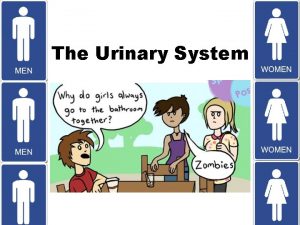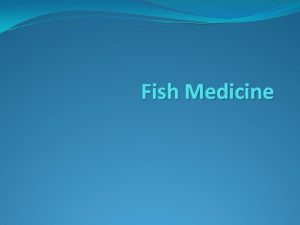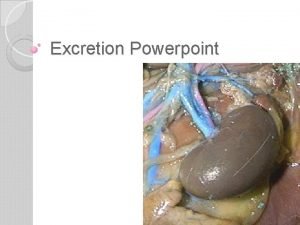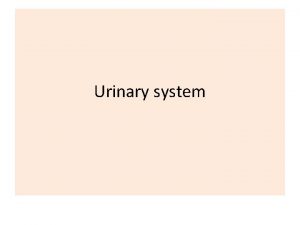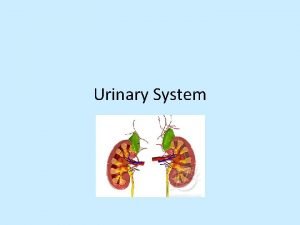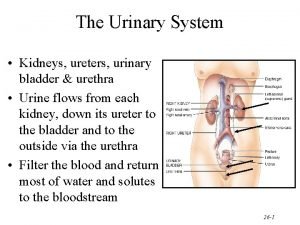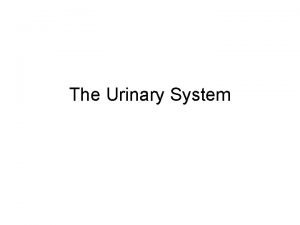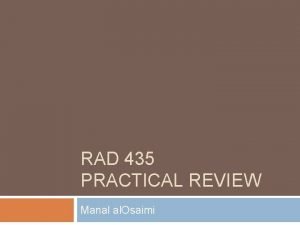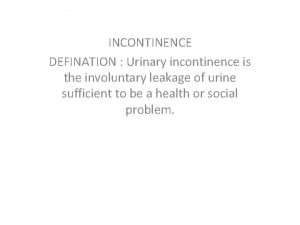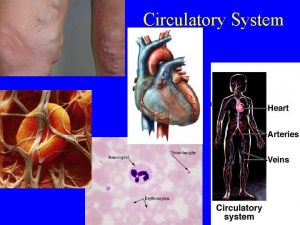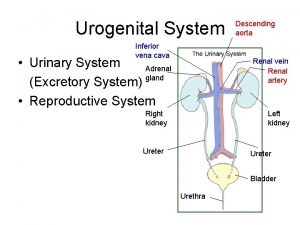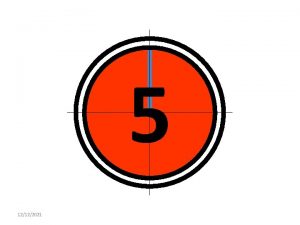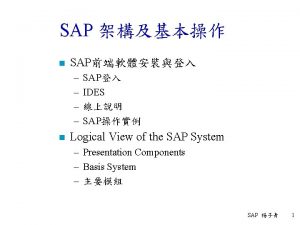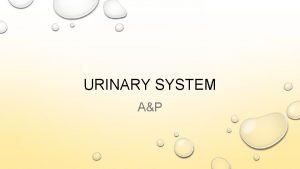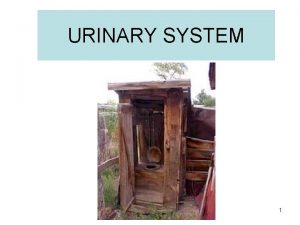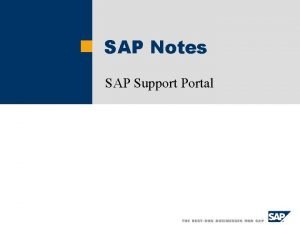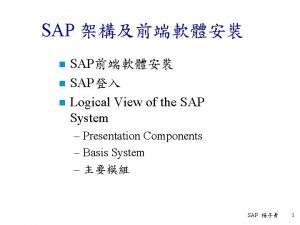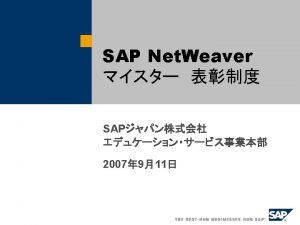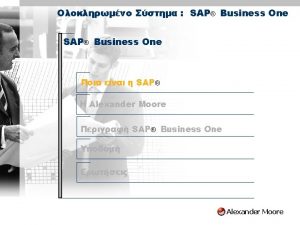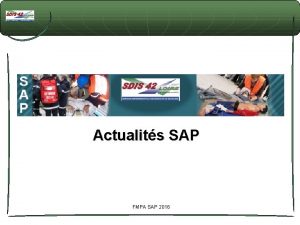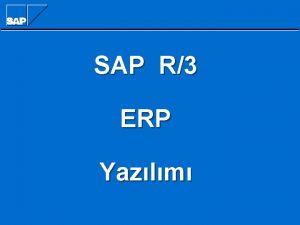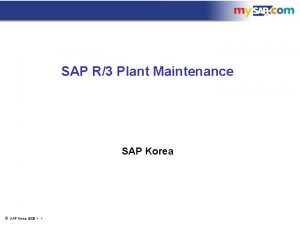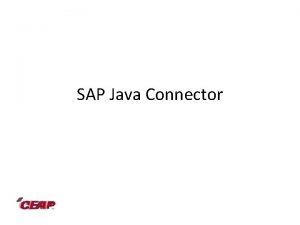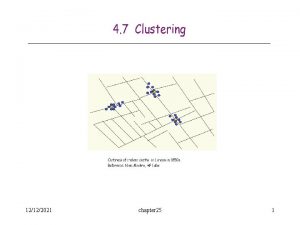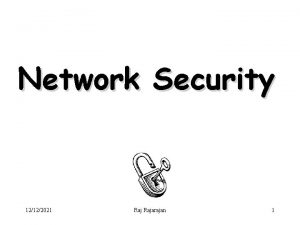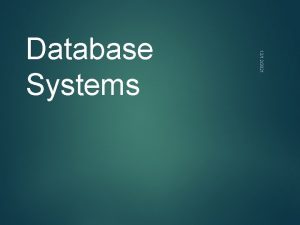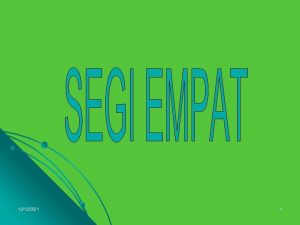12122021 SAP 4 c URINARY SYSTEM 1 12122021






















- Slides: 22

12/12/2021 SAP 4 c URINARY SYSTEM 1

12/12/2021 SAP 4 c 2 Function • Removal of metabolic waste products from the blood and their excretion in the urine • Removal of foreign chemicals from the blood and their excretion in the urine. • Regulation of • Blood volume • Concentration of blood solutes • Acid-base balance • Blood cell synthesis • Production of hormones and enzymes (Renin)

12/12/2021 Structures • Kidneys • Located in the upper dorsal region • Embedded in fat in the back wall • Divided into regions • Renal cortex-outer ridge of kidney • Renal medulla-inner or middle kidney region • Made of medullary pyramids: sections of tubes or calyces • Separated by renal cortex shaped in columns (renal columns) • At the very top of each are the nephrons (million per kidney) SAP 4 c 3

12/12/2021 Structure cont. • Renal pelvis- region located at the hilum where all the smaller calyces drain into a major calyx and leave the kidney SAP 4 c 4

12/12/2021 SAP 4 c 5 Blood Supply • Kidneys continuously cleanse the blood and adjust its composition • ¼ of total blood supply passes through the kidneys • Renal artery • Transports oxygenated blood from the heart and aorta to the kidney for filtration • Renal veins • Transports filtered and deoxygenated blood from the kidney to the posterior vena cava and then the heart • 425 gallons of blood circulated daily, 1/1000 th becomes urine

12/12/2021 Blood Supply cont. SAP 4 c 6

12/12/2021 SAP 4 c 7 Nephron • Functional unit of kidney • Where blood filtration occurs • Makes urine • 3 main parts • Glomerulus • Very high internal pressure • Filtration occurs and pushes everything that will fit through the walls into the Bowman’s capsule (the filtrate) • Bowman’s capsule- receives the filtrate from the capillaries • Renal tubule- reabsorbs all the good stuff from the filtrate; whatever is left becomes urine. • • Proximal convoluted tubule--first segment of a renal tubule Loop of Henle--the extension of the proximal tubule Distal convoluted tubule--connects the Loop of Henle with the collecting tubule Collecting tubule--straight part of a renal tubule

12/12/2021 SAP 4 c 8

12/12/2021 SAP 4 c 9

12/12/2021 Ureters • 10 -12” long • Peristalsis in the walls help to push the urine towards the bladder • Connects the kidney to the bladder • Flaps at the inside prevent urine from backing up into the ureters SAP 4 c 10

12/12/2021 Urinary bladder • Able to collapse and expand • Made of 3 muscle layers that help it expand help to tell you when you need to urinate • Flow of urine out of bladder controlled by 2 sphincters • Internal: no control, opens to allow urine into the urethra • External: partially under voluntary control • Trigone is a triangular region in the bladder where ureters and urethra opening meet-high rate of infection SAP 4 c 11

12/12/2021 SAP 4 c 12 Urethra • The tube that eliminates urine to the outside • In females about 1. 5” long and only used for urine flow • In males about 8” long and used for urine flow and ejaculation

12/12/2021 SAP 4 c 13 Urine Formation • Happens in nephrons • 3 steps • Filtration • Because of high pressure in the glomerulus, particles are pushed from the blood into the Bowman’s capsule • Non-selective; everything that is small enough to fit through pores in capillaries will be pushed into Bowman’s capsule • Passive • At the end of filtration, you have made filtrate • Rate--125 ml per minute or 180, 000 ml (180 liters) in 24 hours; almost 45 gallons

12/12/2021 SAP 4 c 14 Urine Formation cont. • Tubular reabsorption • Active • The capillaries that surround the renal tubule pull some of the good “stuff” back from the filtrate • Water, sugars, amino acids, sodium, vitamins • Tubular secretion • Active • Blood pushes some waste from capillaries into tubules • Some excess vitamins, penicillin, creatine

12/12/2021 Urine composition • 95% water • Other products • Urea: created when we break down proteins and amino acids • Uric acid: made when you break down nucleic acids • Creatinine: made when muscles perform metabolism • Amount--. 6 to 2. 5 liters per day SAP 4 c 15

12/12/2021 SAP 4 c 16 Factors That Affect Urine Formation • Intake of fluids • Sweat/exercise • Medicine • Diet • Temperature/humidity • Emotions

12/12/2021 SAP 4 c Elimination of Urine cont. • Micturition or urination--process by which urine is expelled from the urinary bladder • Path: • Nephron collecting ducts calyces renal pelvis ureter urinary bladder urethra outside of the body 17

12/12/2021 Urinary Disorders • Kidney stones: when the urine is concentrated and does not have much water, the uric acid and the calcium salts can form pellets. • Tends to reoccur • Happens in renal pelvis • Causes pain as they pass through the ureters or urethra SAP 4 c 18

12/12/2021 SAP 4 c 19 Urinary Disorders cont. • Urinary Tract Infection (UTI): general term for infection anywhere in the urinary system • Usually bacterial • Far more common in women • Incontinence: unable to control the external sphincter

12/12/2021 SAP 4 c 20 Urinary Disorders cont. • Acute Kidney Failure- sudden loss of function • Causes: nephritis, shock, injury, heart failure or poisoning • Symptoms: anuria or oliguria. Uremia, nausea, coma, death • Chronic Kidney Failure- gradual loss of function due to hypertension (high blood pressure) or endocrine disease • Cystitis- inflammation of the urinary bladder • Hemodialysis- serves as an “artificial kidney” • Peritoneal dialysis- uses patient’s own peritoneal lining to filter blood • Kidney transplant- Only need one from a suitable donor, must take anti-rejection drugs

12/12/2021 Urinary Tests • Urinalysis can be used to detect certain illnesses from urine. • WBC’s in urine = infection • RBC’s = internal bleeding, crushing injury to the kidney, serious UTI, severe high B/P • Certain proteins (albumin) = high B/Pf • Bile = jaundice, hepatitis, cirrhosis • Glucose = diabetes SAP 4 c 21

12/12/2021 SAP 4 c 22 Abnormalities of Urine • Anuria • Without urine • Cystitis • Inflammation of the bladder • Dysuria • Painful urination • Hematuria • Blood in urine • Hydronephrosis • Too much water in kidney • Pyuria • Pus in urine • Enuresis • Bedwetting • Glycosuria • Sugar in urine • Nocturia • Frequent urination at night • Diuretic • Drug or substance to increase urine production
 Lymphatic and urinary system
Lymphatic and urinary system Urinary system introduction
Urinary system introduction Figure 15-3 the urinary system
Figure 15-3 the urinary system Pyelonephritis medical terminology
Pyelonephritis medical terminology Interesting facts about the integumentary system
Interesting facts about the integumentary system Uterus pig
Uterus pig Chapter 30 the urinary system
Chapter 30 the urinary system Chapter 15 the urinary system figure 15-3
Chapter 15 the urinary system figure 15-3 Chapter 20 urinary/excretory system
Chapter 20 urinary/excretory system Urinary system model
Urinary system model Urinary system fun fact
Urinary system fun fact Optic lobes
Optic lobes Urinary system powerpoint
Urinary system powerpoint The urinary system is also known as
The urinary system is also known as Adh hormone function
Adh hormone function Renal corpuscle
Renal corpuscle Nephron urinary system
Nephron urinary system Sialography
Sialography Defination of urinary system
Defination of urinary system Urinary system label
Urinary system label External anatomy of a rat
External anatomy of a rat Rat urinary system
Rat urinary system Inferior vena cava urinary system
Inferior vena cava urinary system






